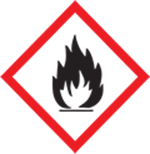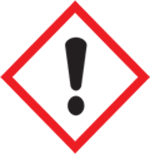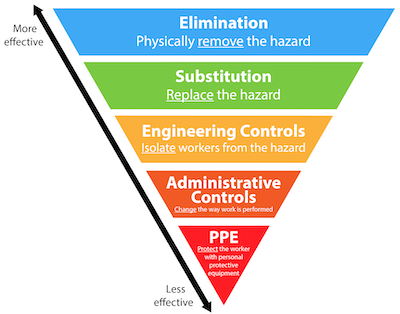Sodium Hydrosulfite
This chemical standard operating procedure (SOP) and the associated Safety Data Sheet (SDS) are for our safety. Read and understand both documents. If this is a paper copy, check for updated versions on the IsoLab website.
Process
Sodium hydrosulfite is used as part of the Sequential Iron Extraction method.
Hazards - SDS


Self-heating; may catch fire. Harmful if swallowed. Causes serious eye irritation. Harmful to aquatic life.
Protection - SDS

Engineering Controls
Use sodium hydrosulfite in a fume hood to avoid the spread of dust and to avoid breathing product sulfurous gases. Ensure the fume hood has proper air flow by checking the flow rate on the control panel and / or using a smoke match or wipe to visualize flow.
PHS - Any fume hood in the 302 / 303 suite will be fine.
Administrative Controls
PHS - Make sure others working close by know that you are working with sodium hydrosulfite and that it is reactive with water. Put a sign on the sash and close the sash if you have to step away from the fume hood.
Personal Protective Equipment (PPE)
PHS - Wear a lab coat, nitrile gloves, and protective eye wear.
Handling - SDS
Keep container tightly closed when not in use. Keep away from water apart from the solutions being created for the sequential iron extraction SOP. Prevent the formation of dust.
PHS - Decontamination - Do not rinse containers used to weigh and dispense sodium hydrosulfite with water. Follow the sequential iron extraction SOP.
Storage - SDS
In general, sodium hydrosulfite must be stored in a flammables cabinet. Use MyChem, the UW EH&S chemical inventory database, to find exactly where in the lab suite this chemical is stored. IsoLab's sodium hydrosulfite is stored in the flammables cabinet under the east fume hood in 303B.
Spills - SDS
Avoid breathing dust.
PHS - Exposure:
- Inhalation - Move to fresh air. For advice, call UW Employee Health Center (206.685.1026) or the Washington Poison Center (800.222.1222). For emergency help, call 911.
- Skin contact - Wash with soap and water. For advice, call UW Employee Health Center (206.685.1026) or the Washington Poison Center (800.222.1222). For emergency help, call 911.
- Eye contact - Rinse with water at eye-wash station for 15 minutes. For advice, call UW Employee Health Center (206.685.1026) or the Washington Poison Center (800.222.1222). For emergency help, call 911.
If the spill is fully contained inside the fume hood, close the sash and prepare yourself to clean it up. Grab the closest spill kit. Make sure you have the appropriate PPE on (lab coat, nitrile gloves, eye protection). Do not allow the substance to enter the drain. Put all generated waste into a bag if you have a lot of debris and a plastic container if only a small amount of debris. See Waste section below.
If the spill is outside of the hood, do not breathe dust and ensure adequate ventilation. Do not let anyone enter the contaminated space until the air is cleared or proper PPE has been donned. Grab the closest spill kit. Make sure you have the appropriate PPE on (lab coat, nitrile gloves, eye protection). Do not allow the substance to enter the drain. Put all generated waste into a bag if you have a lot of debris and a plastic container if only a small amount of debris. See Waste section below.
If you need assistance or advice, use the IsoLab Emergency Contacts sheet.
Consult the EH&S Spill Poster and Exposure Poster
Waste - SDS
If you are cleaning up after a spill and have a bag of debris, ensure the bag is sealed and use multiple bags as needed. Complete an EH&S Hazardous Waste Label and adhere it to the bag. Here are instructions for how to label chemical waste containers. Labels are located in a drawer on the west wall of 303B near the door to the hallway.
Put all waste, solid or liquid, into a plastic container. Options for waste containers can be found under the west sink in 303B. Complete an EH&S Hazardous Waste Label and adhere it to the bottle. Here are instructions for how to label chemical waste containers. Labels are located in a drawer on the west wall of 303B near the door to the hallway.
Place the properly labeled container in one of the gray tubs near the hallway door of 303B. Segregate from other waste containers as appropriate.
Consult our generalized Chemical Waste Disposal SOP.

Training - PHS
Sodium hydrosulfite is deemed a particularly hazardous substance - PHS by EH&S and you need approval before using it. Complete the list of requirements below before using this chemical.
Prerequisites
- You must have completed Managing Laboratory Chemicals in the last three years. Login to check.
- Read and understand the SDS for Sodium hydrosulfite.
- Read, understand, and digitally sign this SOP.
- Contact your Principal Investigator (PI) AND the Chemical Hygiene Officer (CHO) indicating that you have completed all prerequisites and await approval.
